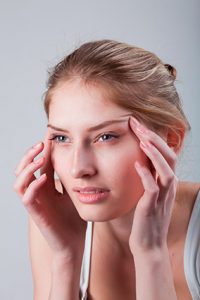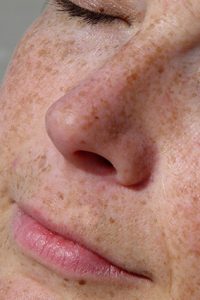6 Reasons Your Skin Looks 10 Years Older (Than It Should!)
1. You’re becoming near-sighted:

As your vision worsens with age, other muscles around the eye pitch in to help you focus, says Ranella Hirsch, MD, past president of the American Society of Cosmetic Dermatology and Aesthetic Surgery. But as these tiny muscles are increasingly taxed, they can deepen lines around the eyes, and that can make you look world-weary (instead of wise). And while injections can improve the appearance of these wrinkles, Hirsch says that it’s also helpful to get your eyes checked. “A patient will come in for a consultation, and I’ll send them to an optometrist,” she says. “Sometimes what they really need is a pair of glasses.”
2. You’re neglecting – or abusing – your teeth:

Teeth add structure and vertical height to the face. When they get worn down through grinding, nail biting or aggressive chewing, or worse, when a diseased tooth needs to be pulled, the facial skin can become looser, explains Phil Haeck, MD, a plastic surgeon based in Seattle and the past president of the American Society of Plastic Surgeons. Combined with the skin’s natural loss of elasticity over time, this can lead to wrinkles and sagging around the mouth. Dentures help fill in the gaps left by missing teeth, but dental implants do a better job at restoring the height of the jaw, Haeck says. You know what to do: Brush twice a day, have your teeth professionally cleaned at least once a year and remember to floss. If grinding is a problem, talk to your dentist about a bite guard.
3. You bought your cheapie sunglasses from a sidewalk vendor:

The delicate skin around your eyes is extremely thin and requires extra attention. Surprisingly, even people who are careful about sun protection often forget to put sunscreen in that area, says Hirsch, which can worsen wrinkles and discoloration. The right pair of sunglasses can serve as another line of defense, but only if they have UVA/UVB protection, as well as lenses opaque enough that you don’t squint in bright light (which can exacerbate frown lines and eye wrinkles, adds Hirsch).
4. You’re taking birth-control pills:

You’ve probably heard of the “mask of pregnancy,” or facial hyperpigmentation caused by hormonal surges during pregnancy. Hormonal birth control (especially pills, shots, the ring) can have the same effect, causing brownish-gray patches to appear like shadows on the upper lip, cheeks, forehead and nose, says Jessuca Krant, MD, a board-certified dermatologist and assistant clinical professor at SUNY Downstate Medical Center. This type of discoloration can add years to your face: A Procter and Gamble study found that women were perceived as older simply because of patchy, uneven skin tone. Fortunately, hormone-induced melasma usually fades within a year of giving birth or going off the pill, provided that you’re religious about sun protection (see reason #6). To treat stubborn spots, Krant suggests talking to your esthetician about brighteners and antioxidants including tretinoin, niacin, vitamin C, kojic acid or azelaic acid.
5. You’re obsessed with losing those last five pounds:

As we get older, hormonal changes can lead to decreases in collagen, Hirsch says. And weight loss can make this more noticeable. “Think of the face as a sofa,” she says. “In the past, when the sofa started to age and sag, women had work done to pull the slipcover—or the skin—tighter. Now we know that one of the most convincing ways to make it look younger is to re-inflate the pillows.” The latest technique to restore fullness involves injecting the face with various soft-tissue fillers, says Hirsch, but adds that you can “protect your facial pillows naturally” by maintaining a healthy, not-too-thin weight.
6. You’re letting the sun win:

So many of us are paying for early sun exposure—skin damage like brownish-gray patches (melasma), brown spots that look like flat moles (lentigos), broken blood vessels and freckles. “Patients often say, ‘The damage is done, and it’s too late to fix it,’” says Krant. But that’s not entirely true: You can prevent additional damage and reduce the severity of the problems you already have if you remain vigilant. “Additional sun exposure can make conditions like melasma even more noticeable. Existing spots can get darker and larger while new ones appear,” explains Krant. Her advice is to embrace excellent sun hygiene (sunscreen, hats, sunglasses—the whole nine yards) as a way of life.

